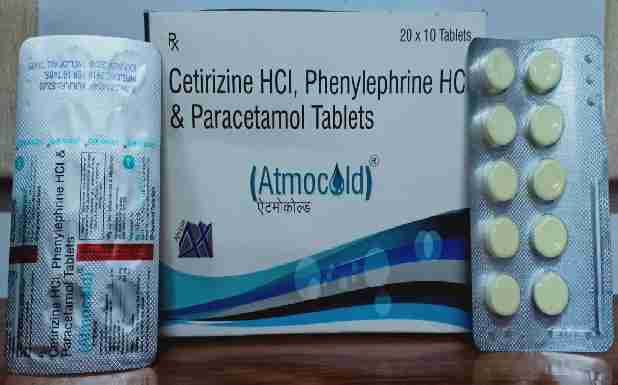
Composition
- Each Film Coated tablet Contains:
- Nimesulide
100 mg
- Paracetamol
325 mg
- Cetirizine
5 mg
- Phenylephrine
10 mg
- Caffeine
25 mg
Packing
- 10X2X10
(Blister)
MRP
- 48
Overview
This product is a combination of Nimesulide, Paracetamol, Cetirizine, Phenylephrine and Caffeine. Caffeine is a stimulant which decreases sleepiness caused by Cetirizine. Cetirizine is an antiallergic which relieves allergy symptoms like runny nose, watery eyes and sneezing. Nimesulide is a non-steroidal anti-inflammatory drug (NSAID). It works by blocking the release of certain chemical messengers that cause pain and inflammation (redness and swelling). Paracetamol is an analgesic (pain reliever) and antipyretic (fever reducer) which also blocks the release of certain chemical messengers in the brain that cause pain and fever. Phenylephrine is a decongestant which narrows the small blood vessels providing relief from congestion or stuffiness in the nose.
Indications?
- Relief from allergic symptoms of the nose or throat
- Relief of sinus pain and headache
- Adjunct with antibacterials in sinusitis, tonsillitis and otitis media
Precautions
Because of its antihistamine component, this product should be used with caution in patients with a history of bronchial asthma, narrow-angle glaucoma, gastrointestinal obstruction, or urinary bladder neck obstruction. Because of its sympathomimetic component, this product should be used with caution in patients with diabetes, hypertension, heart disease, or thyroid disease.
Contraindications
Combination is not recommended for:
Patient with known hypersensitivity to the combination or any of the ingredients of the combination
Side Effects
Very rare but the common side effects are:Nausea
Diarrhea
Vomiting
Allergic reactions
Fatigue
Sleepiness
Headache
Dosage
Oral:
Disclaimer:To be taken only after consulting with the doctor.
Pharmacology
Pharmacodynamics:
Pharmacodynamics Properties of Nimesulide:
Nimesulide is a non-steroidal anti-inflammatory drug (NSAID) with analgesic antipyretic properties. It selectively inhibits cyclooxygenase-2 (COX-2). It is indicated as second line treatment for acute pain, symptomatic treatment of painful osteoarthritis and primary dysmenorrhoea.
Pharmacodynamics Properties of Paracetamol:Paracetamol has analgesic and antipyretic properties. Paracetamol's effects are thought to be related to inhibition of prostaglandin synthesis.
Pharmacodynamic Properties of Cetirizine HCL:Cetirizine is a third generation, non-sedating, selective histamine H1 receptor antagonist, with antihistamine, anti-inflammatory and potential anti-angiogenic activities. Cetirizine competes with endogenous histamine for binding at peripheral H1-receptor sites on the effector cell surface. This prevents the negative symptoms associated with histamine release and an allergic reaction. In addition, as histamine plays an important role in angiogenesis during an allergic inflammatory reaction, blocking the action of histamine may modulate the expression of proangiogenic factors and thus may prevent angiogenesis. As a third-generation histamine H1 receptor antagonist, cetirizine has fewer side effects than most second-generation antihistamines.
Pharmacodynamic Properties of Phenylephrine:It is a sympathomimetic vasoconstrictor that has been used as a nasal decongestant. Phenylephrine constricts the blood vessels in the nasal mucous membranes and allows the air passages to open up. It is relatively selective alpha-adrenoceptor agonist. The majority of the sympathomimetic action is due to direct stimulation of the adrenoceptors. At therapeutic doses, it does not cause significant stimulation of the central nervous system.
Pharmacodynamic Properties of Caffeine:Caffeine is a central nervous system (CNS) stimulant. Caffeine enhances the analgesic activity of Paracetamol.
Pharmacokinetics:
Pharmacokinetics Properties of Nimesulide:
The drug is rapidly and extensively absorbed. Nimesulide is rapidly distributed, extensively bound to albumin and eliminated with a terminal half-life of about 4 h. Nimesulide is almost exclusively metabolized and cleared by the liver Excretion of the unchanged drug in urine and faeces is negligible. Nimesulide is mainly cleared from the body by metabolic transformation and the principal active metabolite is the 4′-hydroxyl derivative (M1). Metabolic biotransformation of Nimesulide in the liver can occur at both the phenoxy ring moiety and the aromatic nitro group. The major oxidative metabolite found in the plasma is para-hydroxy nimesulide in both free and conjugated forms and this metabolite also appears to contribute to the anti-inflammatory activity of the compound.
Pharmacokinetics Properties of Paracetamol:
Paracetamol is rapidly and completely absorbed from gastrointestinal tract. Peak plasma is achieved within 0.5 to 2 hrs. The drug is metabolized in the liver. 90% of the drug is excreted through urine.
Pharmacokinetics Properties of Cetirizine HCL:
Absorption: Cetirizine is rapidly and extensively absorbed. In adults, peak plasma concentrations are achieved 0.9 hour after administration. The accumulation ratio following daily administration is 1.12 with steady state achieved after 2 days.
Distribution:Approximately 0.4 L/kg
Metabolism: Cetirizine is poorly metabolized and mostly excreted. This is favourable as it is unlikely to be modified by drugs administered concomitantly.
Elimination:The half-life is about 8 to 9 h. Elimination is 85.4% and 12.9% via urine and feces, respectively. Excreted both by glomerular filtration and active tubular secretion
Phenylephrine is absorbed quickly and completely. The biological half-life is 2-3 hrs. It is mainly excreted via the kidneys. The therapeutic plasma concentrations of Phenylephrine are described as 0.04-0.1µg/ml.
Pharmacokinetics Properties of Caffeine:
Absorption: When ingested, it has near perfect intestinal uptake of around 99-100% up to acute dosages of 10mg/kg bodyweight, the highest studied in humans. This absorption tends to occur almost completely within 45 minutes of ingestion.
Metabolism: caffeine can be metabolizes into dimethylxanthine derivatives (paraxanthine, theobromine, and theophylline) and further metabolized into monoxanthine derivatives and then finally a xanthine molecule.
Distribution:Caffeine is hydrophobic enough to tranverse most barriers in the body and is readily distributed to all organs.